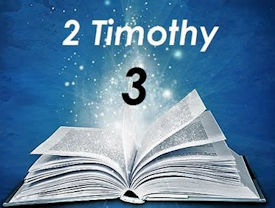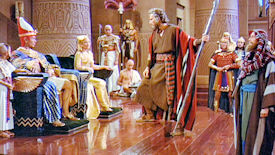Paul’s Second Epistle to Timothy is believed by some scholars to be the last letter written before his death in Rome.1 Paul encouraged Timothy by saying “hold to the standard of sound teaching that you have heard from me, in the faith and love that are in Christ Jesus” (2 Timothy 1:13, NRSV).2
Our study concerns chapter three of this book. In it, the apostle warns Timothy what the last days would be filled with evil and explains that the “net of the gospel was to enclose both good fish and bad.” The bad catch, with a general corruption of manners, morals, and tempers, would make for a dangerous time and might tempt us to question our faith. We should not be surprised when we see those times as perilous.3
The first nine verses complete a list of specific transgressions based on God’s wrath of unrighteousness contained in the Book of Romans (Romans 1:29-31). These vices are an indictment of pagan morals and establish the things Christians should not do. But because such practices were still going on, they show that a lax spirit had invaded the church and it is Timothy’s duty to identify and oppose those things.4
 (2 Timothy 3:1-9): 1 You must understand this, that in the last days distressing times will come. 2 For people will be lovers of themselves, lovers of money, boasters, arrogant, abusive, disobedient to their parents, ungrateful, unholy, 3 inhuman, implacable, slanderers, profligates, brutes, haters of good, 4 treacherous, reckless, swollen with conceit, lovers of pleasure rather than lovers of God, 5 holding to the outward form of godliness but denying its power. Avoid them!
(2 Timothy 3:1-9): 1 You must understand this, that in the last days distressing times will come. 2 For people will be lovers of themselves, lovers of money, boasters, arrogant, abusive, disobedient to their parents, ungrateful, unholy, 3 inhuman, implacable, slanderers, profligates, brutes, haters of good, 4 treacherous, reckless, swollen with conceit, lovers of pleasure rather than lovers of God, 5 holding to the outward form of godliness but denying its power. Avoid them!
6 For among them are those who make their way into households and captivate silly women, overwhelmed by their sins and swayed by all kinds of desires, 7 who are always being instructed and can never arrive at a knowledge of the truth.
8 As Jannes and Jambres opposed Moses, so these people, of corrupt mind and counterfeit faith, also oppose the truth. 9 But they will not make much progress, because, as in the case of those two men, their folly will become plain to everyone.
“The last days are the years between the ascension of Jesus to heaven and his return to earth in glory. They are the times in which we live.”5 This indicates these problems would be a common and continuing trouble for the Church. Today, most people following these practices, listed in verses two through five, do not even realize they are living and acting as pagans. Outwardly they may seem devout — they make a profession of Christianity — but their actions speak louder than their words. “They will maintain a façade of ‘religion’, but their conduct will deny its validity.”6
Those Silly Women!
What is meant by verse six, when it says, “those who . . . captivate silly women?” One commentary states it is about those people who “creep or worm their way into households. It is not by accident that this description reminds us of the movement of a serpent. If they revealed their true identity, they would not succeed in getting into many of these homes, but they use various subtle devices, such as speaking about God, the Bible, and Jesus (even if they do not believe what Scripture teaches about these).”7 This suggestion is quite reasonable to me; after all, with the new freedoms women had following Jesus’ teachings, they were eager to learn.
 But many commentators believe it is more about misbehaving women, who lack seriousness. One writer said male solicitation and influence is exercised over ‘weak’ women.8 Another suggested it was about foolish younger women, who were overwhelmed by guilt from their past sins. He implied that false teachers took advantage of them.9
But many commentators believe it is more about misbehaving women, who lack seriousness. One writer said male solicitation and influence is exercised over ‘weak’ women.8 Another suggested it was about foolish younger women, who were overwhelmed by guilt from their past sins. He implied that false teachers took advantage of them.9
Maybe I’m wrong, but it seems that some scholars believe those women just weren’t as smart as men. To me, biblical evidence doesn’t support that attitude as valid. They may have been deceived, as was Eve in the garden of Eden, but they weren’t of lessor intelligence. Besides, it doesn’t really state who is deceiving the women; was it men, women, or something else?
Let me toss in another idea, an odd one from the far fringe of thought. One biblical researcher believes that ‘silly’ women in verse 6 should have been translated as ‘little’ women, for that is what the Greek word indicates.10 He believes the two men mentioned in verse 8, who opposed Moses, were of Nephilim bloodlines. (We will consider these two men, Jannes and Jambres, in the next section.) Anyway, he thinks such ungodly human-angel creatures lustfully abducted smaller women, just as was done during Noah’s time.11 For a study of the Nephilim, see additional articles listed in References & Notes.12
Who were Jannes and Jambres?
In verses 8 and 9, Paul reminds Timothy about the magicians in Egypt, Jannes and Jambres, who opposed Moses’ during meetings with the King of Egypt. This is the only place in the entire Bible that these men are named, though they would have been familiar to Paul and Timothy from various Jewish writings about Moses.13 Below is scripture from Exodus, which describes the meeting.
The LORD said to Moses and Aaron, “When Pharaoh says to you, ‘Perform a wonder,’ then you shall say to Aaron, ‘Take your staff and throw it down before Pharaoh, and it will become a snake’.” So Moses and Aaron went to Pharaoh and did as the LORD had commanded; Aaron threw down his staff before Pharaoh and his officials, and it became a snake. Then Pharaoh summoned the wise men and the sorcerers; and they also, the magicians of Egypt, did the same by their secret arts. Each one threw down his staff, and they became snakes; but Aaron’s staff swallowed up theirs. Still Pharaoh’s heart was hardened, and he would not listen to them, as the LORD had said,” (Exodus 7:8-13).
According to Jewish custom, Jannes and Jambres are the two legendary sorcerers in Egypt. Their names appear in various sources as the adversaries of Moses and Aaron. These sources include both Greek and Roman literature, as well as the Dead Sea Scrolls.14 Even earlier, references to Jannes and Jambres go back at least to the time of the Second Temple, as they are mentioned in the Damascus Document (also called Damascus Rule or the Sadokite Documents). They were found prior to the Qumran cave discoveries (1947-1956) in an old Cairo synagogue in 1896.15 Here are a few other sources of the names of these Egyptian magicians.
In rabbinical tradition they were also the two chiefs of the magicians at the court of Pharaoh who foretold the birth of Moses, “the destroyer of the land of Egypt,” thereby causing the cruel edicts of Pharaoh. When Moses performed his miracles with the water and the rod, they said, “Dost thou wish to introduce magic into Egypt, the native land of the magic art?” Other Jewish texts say they were among “the mixed multitude that went up with Israel from Egypt” (Exodus 12:38) and aided in the making of the golden calf.16
Some references to Origen’s commentary on Matthew, say that Origen believes that Paul got his knowledge from a book by the name of The Apocryphon of Jannes and Jambres. This is an elusive book, reportedly in circulation during the time of Paul.17 These two men “were important in Jewish folklore because the inadequacy of their magic before God proved that secular magicians, who were rife in ancient times, could offer no substitute for true faith.”18
 The Book of Jasher, or Book of the Upright One (Sefer ha-Yashar in Hebrew), is a detailed account of the Torah by 12th-century Jewish philosopher and commentator Abraham ben Meir ibn Ezra.19 This rabbinical text adds details to many biblical events, such as the flood of Noah, the character, conduct, and government of Nimrod, and Joseph’s great procession in Egypt, upon coming into power. One narrative in this book tells the story of when Moses and Aaron first came to meet the King of Egypt, to convince him to let the Hebrews leave, and it makes mention of Jannes and Jambres.
The Book of Jasher, or Book of the Upright One (Sefer ha-Yashar in Hebrew), is a detailed account of the Torah by 12th-century Jewish philosopher and commentator Abraham ben Meir ibn Ezra.19 This rabbinical text adds details to many biblical events, such as the flood of Noah, the character, conduct, and government of Nimrod, and Joseph’s great procession in Egypt, upon coming into power. One narrative in this book tells the story of when Moses and Aaron first came to meet the King of Egypt, to convince him to let the Hebrews leave, and it makes mention of Jannes and Jambres.
And Pharaoh said to Moses, “What do you require?” and they answered him, saying, “The Lord God of the Hebrews has sent us to thee, to say, ‘Send forth my people that they may serve me’.” And when Pharaoh heard their words he was greatly terrified before them, and he said to them, “Go today and come back to me tomorrow,” and they did according to the word of the king.
And when they had gone, Pharaoh sent for Balaam the magician and to Jannes and Jambres his sons, and to all the magicians and conjurors and counselors which belonged to the king, and they all came and sat before the king,” (Jasher 79:25-27, [1840 translation published by J. H. Parry & Company]).20
So, as one author wrote, “Jannes and Jambres, therefore, provide an illustration and a warning. There always will be people who oppose the truth, thinking they act in the service of a cause they do not know is lost. They may be able to ‘work their magic’ and deceive for a time, but a moment will come when their foolishness will be evident to all.”21
Their names are just small details easily overlooked when studying Paul’s letter to Timothy. While it requires some investigation to understand Paul’s reference to these men and why he makes it, the effort is worthwhile in the end.22
Must we use other sources when the Bible contains all we need?
To obtain this information about Jannes and Jambres, we had to travel down a rabbit hole (once again) searching for scattered details about whom they were. Do we really need outside information to learn about the Bible? Will doing so compromise our clarity and lessen the quality of our Bible study? To answer these questions, let me quote from author, ordained minister, teacher, and Writer-in-Residence at Tyndale House, Christopher Ash.
“If we insist that we need only the Bible to understand the Bible, we run up against some pretty serious difficulties. For a start, we need scholarship to give translations and we need scholarship to point us towards the original text of Scripture. Otherwise we will be reduced to reading the Old Testament in Hebrew (or Aramaic) and the New Testament in Greek, and even then we won’t be sure which is the most accurate manuscript to consult. So there are some pretty basic reasons why we should be grateful that God has given us reliable scholarship.”23
 “And when it comes to Jannes and Jambres, the fact is that we do know that these names were used of Pharaoh’s magicians. It’s not essential to our salvation to know this, but it makes perfect sense of the way Paul uses them in 2 Timothy 3, supposing his first hearers would also have known this (as seems likely). And it adds depth and poignancy to what Paul says, when we see the false teachers as in league with these ancient enslavers.”24
“And when it comes to Jannes and Jambres, the fact is that we do know that these names were used of Pharaoh’s magicians. It’s not essential to our salvation to know this, but it makes perfect sense of the way Paul uses them in 2 Timothy 3, supposing his first hearers would also have known this (as seems likely). And it adds depth and poignancy to what Paul says, when we see the false teachers as in league with these ancient enslavers.”24
The video selected for the theme of this article is a sixty-five-year-old film clip from the epic religious drama, The Ten Commandments, which was produced and directed by Cecil B. DeMille in 1956. I saw this motion picture with my parents, when it first debuted; I was 13 years old. This scene (less than five minutes long) portrays God’s representatives, Moses and his brother Aaron, competing against the Pharaoh’s magicians, Jannes and Jambres, as they cast their staffs which turn into serpents. See References & Notes for a link to the movie clip.25
![]()
Copyright © 2021, Dr. Ray Hermann
OutlawBibleStudent.org
→ Leave comments at the end, after ‘References & Notes’.
Your email address will NOT be published. You can view our basic rules for comments by clicking “The Fine Print” on the top menu bar.
References & Notes
- Murphy-O’Connor, Jerome, Paul: A Critical Life, (Oxford: Clarendon Press, 1996), p. 356.
- Unless otherwise stated, all scripture is from New Revised Standard Version Bible, Division of the National Council of the Churches of Christ in the USA, 1989. Used with permission.
- Henry, Matthew, Matthew Henry’s Commentary on the Whole Bible, (Peabody, MA: Hendrickson Publishers, 1991), vol. 6, pp. 678-679.
- Mays, James Luther, (Ed.), Harper’s Bible Commentary, (San Francisco: Harper & Row, 1988), p. 1242.
- Knowles, Andrew, The Bible Guide, (Minneapolis, MN: Augsburg Publishing, 2001), p. 653.
- MacDonald, William, Believer’s Bible Commentary: Old and New Testaments, (Ed.) Arthur Farstad, (Nashville TN: Thomas Nelson, 1995), p. 2120.
- Ibid.
- Mays, James Luther, (Ed.), Harper’s Bible Commentary, (see above).
- Barry, John D., et al., Faithlife Study Bible, (Bellingham, WA: Lexham Press, 2012, 2016), 2 Timothy 3.
- Strong’s Greek #1133: γυναικάριον, gunaikariŏn; a little woman; silly woman.
Strong, James, The New Strong’s Complete Dictionary of Bible Words, (Nashville, TN: Thomas Nelson Publishers, 1996). - Ben-Nun, Steven, “Biblical Discovery Unfolds Last Day Agenda”, (Israeli News Live [DeNoon Institute of Biblical Research], 26 October 2021) – VIDEO BIBLE STUDY: https://youtu.be/JtPohLmfHI0
- (1) “The Apostles’ Creed — Why does it say Jesus Descended into Hell?”, https://outlawbiblestudent.org/the-apostles-creed-why-does-it-say-jesus-descended-into-hell/
(2) “What are Demons and the Nephilim? — and that Mayhem before the Flood of Noah?”, https://outlawbiblestudent.org/what-are-demons-and-the-nephilim-and-that-mayhem-before-the-flood-of-noah/
(3) “When the sons of God were having sexual relations with the daughters of humankind — the story of the Nephilim”, https://outlawbiblestudent.org/when-the-sons-of-god-were-having-sexual-relations-with-the-daughters-of-humankind-the-story-of-the-nephilim/
(4) “Angels from Heaven or Aliens from Outer Space?”, https://outlawbiblestudent.org/angels-from-heaven-or-aliens-from-outer-space/ - Kassian, Mary A., in CSB Study Bible: Notes, Blum, Edwin, et al., (Eds.), (Nashville TN: Holman Bible Publishers, 2017), p. 1931.
- “Jannes and Jambres”, (Encyclopedia Judaica, 25 October 2021), https://www.encyclopedia.com/religion/encyclopedias-almanacs-transcripts-and-maps/jannes-and-jambres
- Vermes, G., The Dead Sea Scrolls in English, (London: Penguin Group, 1987), p. 81.
- Singer, Isidore, (Ed.), The Jewish Encyclopedia: A Descriptive Record of the History, Religion, Literature, and Customs of the Jewish People from the Earliest Times to the Present Day, (New York and London: Funk & Wagnalls, 12 Volumes, 1901–1906 [now reprinted by KTAV Publishing House]), vol. 7, p. 71.
- Enoch, Christopher, “Jannes and Jambres” [section: “The Apocryphon of Jannes and Jambres”], (Christopher Enoch: First Century Christianity, 26 December 2019), https://christopherenoch.org/jannes-and-jambres/
- Losch, Richard R., All the People in the Bible: An A–Z Guide to the Saints, Scoundrels, and Other Characters in Scripture, (Grand Rapids, MI: William B. Eerdmans Publishing Company, 2008), p. 187.
- “Abraham ibn Ezra”, (Wikipedia, Wikimedia Foundation, 27 October 2021), https://en.wikipedia.org/wiki/Abraham_ibn_Ezra
- The Book of Jasher, [possibly compiled in the original language by Abraham ben Meir ibn Ezra of the 12th century; translated to English by Moses Samuel in 1840], (Muskogee OK: Artisan Publishers, 1988), pp. 223-224.
- Longhenry, Ethan R., “Jannes and Jambres”, (Spiritual Manna, 17 October 2012), https://www.spiritualmanna.info/jannesjambres/
- Ibid.
- Ash, Christopher, “The strange case of Jannes and Jambres”, (Tyndale House, 3 April 2020), https://tyndalehouse.com/explore/articles/the-strange-case-of-jannes-and-jambres/
- Ibid.
- Ten Commandments, a motion picture, (scene: Moses Returns to Egypt and Warns Pharaoh), staring Charlton Heston and Yul Brynner, directed by Cecil B. DeMille, distributed by Paramount Pictures, 8 November 1956, (used under ‘fair use’ copyright for teaching under Section 107 of Copyright Act of 1976) – MOTION PICTURE CLIP: https://youtu.be/efug–txDCc

